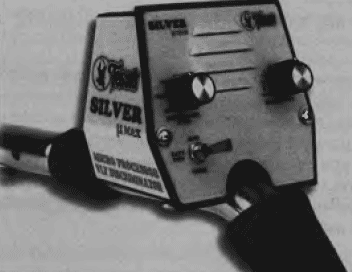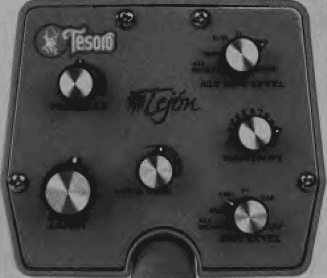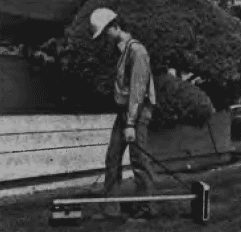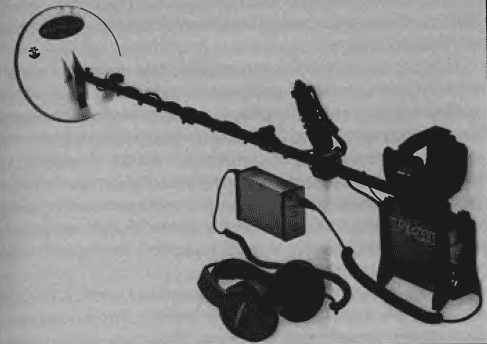Depending on the level of service, price and destination, the detectors can be divided into instruments for beginners, instruments of the middle class, devices with microprocessor, depth gauges, underwater devices and specialized devices for search of native gold.
Instruments for beginners are designed primarily to resolve simple search tasks. It is, as a rule, dynamic VLF options, i.e. devices that require continuous movement of the search coil. Signal occurs only when moving coil over the object. If the coil stop on the metal, the signal will disappear.

Fig. 15. The control panel of the metal detector Silver μМАХ company Tesoro
The dynamic principle has its advantages:
- automatic detuning from the "middle" of the soil;
- extremely easy setup, carried out according to the formula of "plug and go", leading to cost reduction and high reliability of the device.
Among the disadvantages are:
- the decrease in sensitivity compared to static devices;
- inaccurate localization of the object;
- inconvenience when working in areas or heavily littered areas.
Instruments of the middle class have both static and dynamic modes, although the devices the 70s-80s were often purely static.
These instruments are characterized by high sensitivity and good resolution ability. They can be equipped with several interchangeable search coils different diameter (sometimes oval). The number of authorities comes to 8, the procedure of their setting requires a certain skill and lasts for several minutes.

Fig. 16. The control panel of the Tejon metal detector company Tesoro
So, for example, manual ground balancing is to make the rotation the respective knob to achieve the same initial signal with a raised and lowered to the ground coil of Discrimination in such devices usually multistage searchable all metals (All Metal). Management complemented by a button fast adjustment in the arm or on the body. In these the devices are still not used microprocessors - hence the large number of bodies management.
Computerized devices allow with high probability to judge the nature of the findings. This could either be used in the circuit of the device of the microprocessor.

Fig. 17. Computerized Spectrum XLT company White's
Distinctive features of computerized devices is the presence of LCD screen (or dial gauge) and a minimum the number of touch keys to enter programs. The programme refers to the set of virtual States (not deduced on the front panel) bodies management. These controls require using the screen and a few buttons. In memory often has some programs for searching in different conditions: on the beach, in a Park, in buildings, etc. When searching for such a device findings for each measure amplitude and phase characteristics that allows the classification of finds. Often devices themselves conduct the classification, giving the screen or on the dial gauge result. The number of gradations of the measured parameter varies from 8 to 190, allows you to find and enter into the memory of the device is its own program, rather exactly meet your needs when searching in specific conditions. So by the way, according to your desire you can install any scheme of discrimination junk finds.
Deep devices to search for large items (large considered the subject with surface area more than 400 sq. cm) produced almost all major American firms and a number of German firms. There are two type of in-depth devices - RF and IP.
Increasing the depth of RF devices is carried out by transmitting and explode the reception coils (flat) in space. Both coils are rigidly mounted on post. In this case, one coil is in the working position of the device is parallel to the surface of the earth, the other perpendicular. Dimensions of the coils approximately 25x40 see One of the coils emits electromagnetic waves with frequency 12-82 kHz, the other receives the reflected signal. Pulse deep devices (IP) have the search coil is usually in the form of a square frame of size 1x1 meter or 1,5x1,5 meters. Deep the devices can detect objects the size of only more than 10 cm.

Fig. 18. Deep metal detector Geminy-3 firm Fisher
Underwater devices are those that withstand immersion to larger depths (80 m), and can exclude the influence of salt or fresh water environment as search. It should be noted that almost all of the above devices have sealed search coil that allows you to immerse them in a water depth the length of the rod and to search in shallow water, but it is not possible to classify the device underwater.

Fig. 19. Control panel underwater metal detector Tiger Shark company Tesoro
In most underwater devices used pulse induction principle, which significantly reduces the impact on the search for water, moist and wet soils as conductive medium. The instruments of this class are automatically configured to the environmental conditions (salinity of the soil, salinity, etc.). However, they do not always accurately distinguish between metals. Of course, all underwater devices it is possible to use and to search in the air.
Specialized equipment to search for gold nuggets is a task worthy own technical solutions. The thing is, when the discovery of gold universal VLF/TR devices fine particles of the metal can be taken device for grains of ferrous metals and not be detected.

Fig. 20. The metal detector GPX-4000 firm Minelab, the main purpose of which is the search of native gold
In addition, the outputs of gold are often accompanied by "black sand" that contains magnetite, as well as strong ground mineralization. To overcome these phenomena increasing the operating frequency of 2-10 kHz (universal devices) to 18-70 kHz (specialized equipment for search gold) and use the elliptical search coils.
Author: L. V. Bulgak






